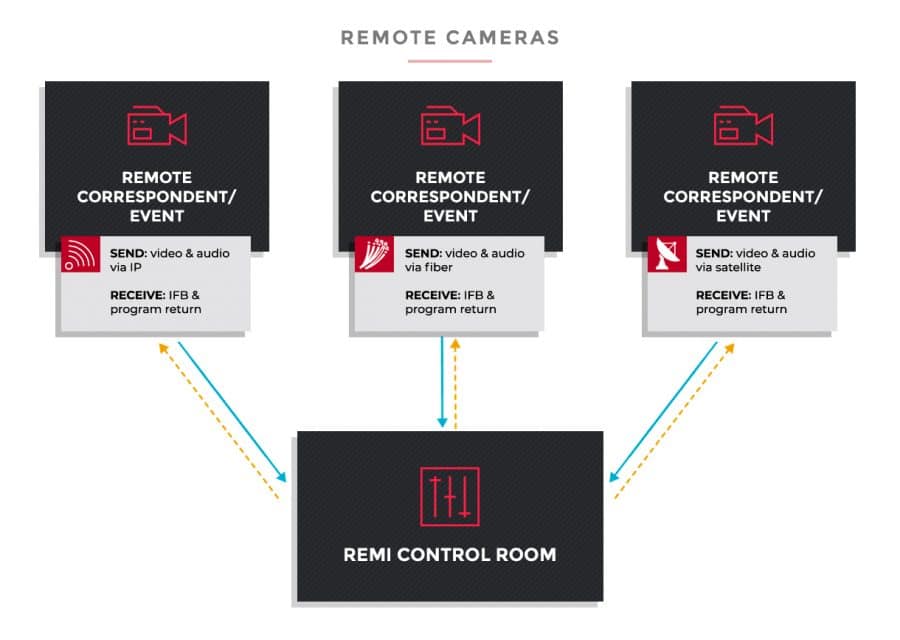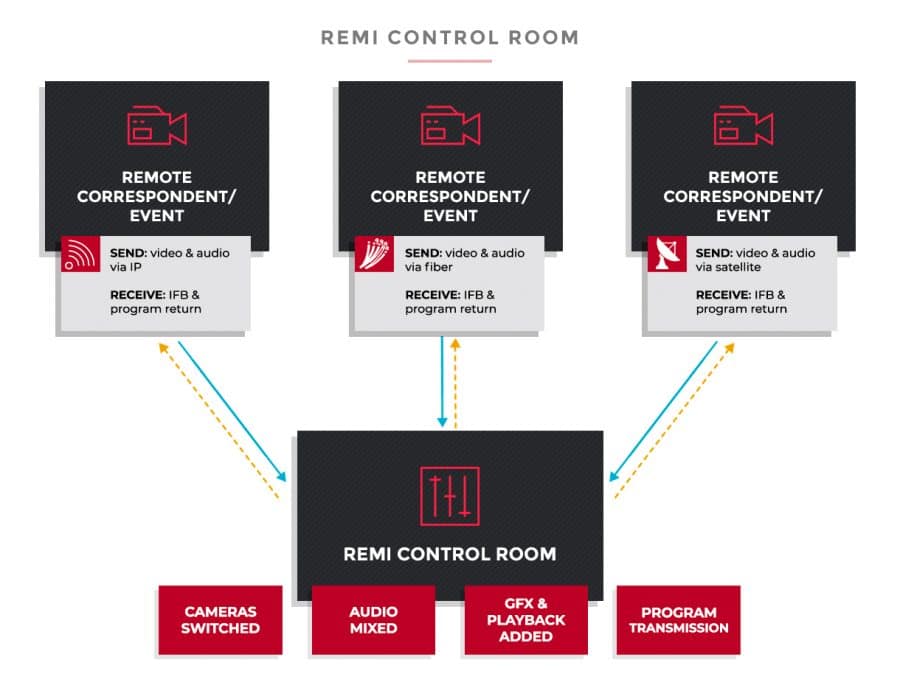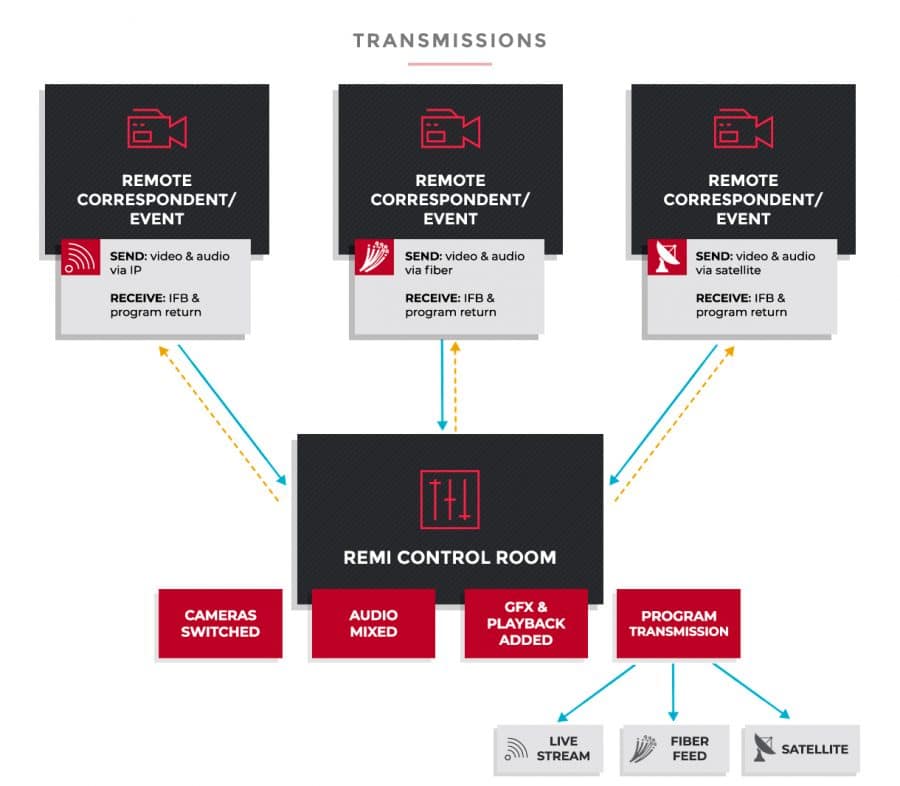There’s a buzzword making rounds inside and outside the broadcast community. REMI production (also referred to as “remote production,” “virtual production,” or “at-home production.”) It’s a sign of the times. With social distancing requirements still in place, content producers continue to seek methods to create live content from remote locations.
So, what exactly is a REMI production?
REMI – or Remote Integration Model – is a production workflow that allows live content to be captured from a remote location and managed from a central control room. A REMI production maintains all of the key production elements that you’d find in a standard broadcast. The key difference is that your on-camera talent is in a remote location.
In today’s climate, with people unwilling or unable to leave their homes, a REMI production workflow makes sense. And it’s one that’s being heavily utilized by production companies and content creators throughout the country.
Let’s take a closer look at REMI productions, how they work, and when they can be used.
Capturing video and audio for a REMI production
 Any REMI production starts with capturing video and audio in the field. Regardless of the content you’re producing, you need a mechanism for capturing high-quality video and audio of your talent. Each of these video and audio signals then needs to be transmitted to a central control room.
Any REMI production starts with capturing video and audio in the field. Regardless of the content you’re producing, you need a mechanism for capturing high-quality video and audio of your talent. Each of these video and audio signals then needs to be transmitted to a central control room.
REMI production workflows have been utilized in the sports world for years (more on that later). With a live sports production, you’re dealing with multiple cameras that all need to be transmitted to a central control room. This requires a more comprehensive camera setup at the local stadium and a reliable mechanism for transmitting those video and audio feeds.
If you’re producing a live news or entertainment program where you have individual correspondents in remote locations, your field camera kits can be more streamlined and efficient.
Your camera and audio needs in the field can vary, but they are a necessary part of any REMI production.
At Broadcast Management Group, we have developed three drop kits as part of our Live At Home REMI solution. Cameras consist of either an iPad Air (for our basic kit) or a 4K PTZ robotic camera (for our Pro and Pro+ packages).
Key components of your REMI control room
 All REMI production workflows rely on a central control room. This is where all of your camera and audio signals are fed and where your primary switching, mixing, and transmission takes place.
All REMI production workflows rely on a central control room. This is where all of your camera and audio signals are fed and where your primary switching, mixing, and transmission takes place.
Your REMI control room can range from a flight pack to a dedicated control room to a production truck. Your REMI control room can – and will – vary depending on your needs. And those needs will be dictated by the content that you’re producing.
Generally speaking, a REMI control room will need the following:
- Video switcher
- Audio mixer
- Graphics system
- Record and playback system
- Comms system
- Inbound and outbound transmission capabilities
Again, these are baseline requirements. Your content will dictate the technical needs.
An added aspect that we have integrated into our Live At Home REMI solution is virtual set technology. By shipping a green screen to our talent, we can create a completely customizable, branded virtual backdrop that fits the program’s aesthetic.
Transmission capabilities
 Transmission and connectivity are HUGE components of a successful REMI production.
Transmission and connectivity are HUGE components of a successful REMI production.
Your transmission needs can be broken down into three categories:
- Connectivity at your primary talent location
- Incoming transmission capabilities at your REMI control room
- Outbound transmission capabilities at your REMI control room
From your primary talent location, you’ll need to send video and audio signals with little to low latency. For a live sports production utilizing REMI, these signals might be sent back via fiber or satellite. With a single-camera feed, an IP-based solution – like LiveU – may be sufficient. For anything IP-based, it’s important to assess your local bandwidth availability in advance. The best remote transmission method will depend on what’s available to you at your primary location and your budget tolerance.
At your REMI control room, you’ll need the ability to RECEIVE all of your incoming feeds. For example, if you’re remotely switching a sporting event with eight cameras, your REMI facility will need to have the infrastructure available to receive those eight signals. The receive infrastructure is not always a one-to-one ratio. Meaning you don’t always need one receiver for every one incoming feed. For example, LiveU’s LU-2000 server can bring in up to four remote feeds.
Finally, you’ll need the ability to SEND your signal somewhere. This may mean streaming live to the web, or sending your signal out via fiber or satellite. This piece of the transmission puzzle is dependent on your content goals. For any of the options above – IP, fiber, or satellite – your REMI facility will need to have the appropriate equipment and outbound connectivity.
Applications for REMI production
Now that we’ve covered REMI production from a high level, it’s time to dig into some possible applications. What type of programming can utilize a REMI workflow?
Live Sports
We’ve already mentioned live sports. REMI workflows have been utilized for live sporting events for quite some time. From a cost perspective, REMI is an ideal solution. Even with a streamlined remote production, there are still a set number of hard costs: technical crew, OB trucks, transmissions, travel, etc. If you’re a large organization, like ESPN, with plenty of physical infrastructure and available capacity, REMI makes a lot of sense financially. You’re able to streamline your remote team while utilizing in-house staff and existing infrastructure.
Live News
Outside of live sports, REMI production workflows can be utilized for live news programming and events. REMI is a perfect fit for live or live-to-tape interviews with multiple guests spread across numerous destinations. Each on-camera talent can be sent a drop kit before the production. Video and audio feeds from each of those kits can be transmitted to a central control room where the program can be switched, audio can be mixed, graphics and playback assets can be added, and the program can be transmitted.
Live Entertainment
REMI production also has a place in the entertainment space. We’ve had many clients inquire about converting previously planned in-person events into virtual experiences. This has ranged from town hall productions to award shows, to fundraisers and galas. While each event is unique and has a distinct creative approach, the technical infrastructure is consistent. Anyone on-camera receives video and audio equipment, which is transmitted to a central location.
While REMI workflows have been deployed for years, they have historically been utilized in the sports world. But with remote working here for the foreseeable future, a REMI production can be an ideal solution for news and entertainment programming.
If you have a question about REMI production or are looking for production support for an upcoming live remote, contact us any time.














Wow, I am always learning something new